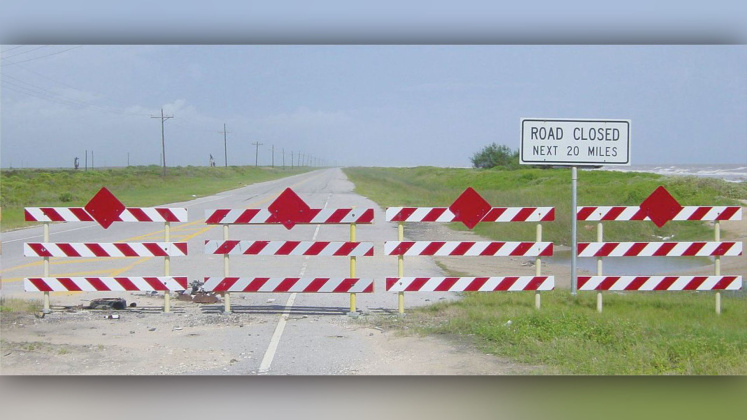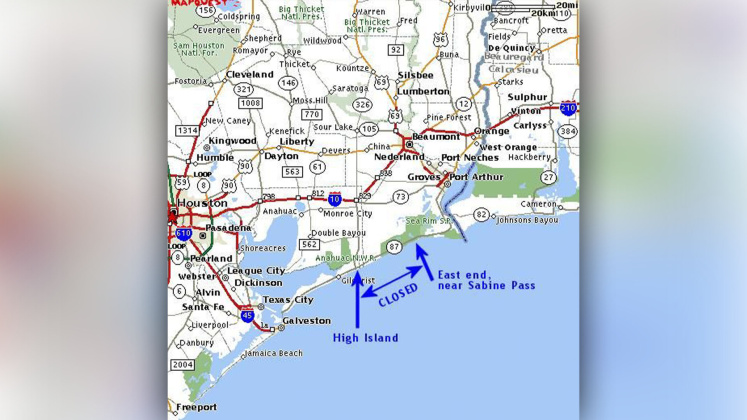The Sabine Pass Port Authority is hosting a public meeting to share information and gather input on the feasibil- ity of reconstructing both State Highway 87 in Sabine Pass and Jetty Road in Port Arthur, as well as future port projects, seeking to give the community the Beach Road access it once enjoyed pre1990. The in-person meeting is set for 5:30–7:30 p.m. Thursday, July 27, at the Sabine Pass ISD Cafeteria, 5641 South Gulfway Dr., in Sabine Pass.
The segment of SH 87 up for discus- sion, also known has Beach Road, has been closed since October 1989 due to severe damage from Hurricanes Allen (1980) and Jerry (1989), leaving the Sabine Pass community with only one access route and an unprotected coastline. Hurricanes Rita (2005) and Ike (2008) added to the destruction, tearing up the SH 87 roadbed between Sea Rim Park and High Island.
Damaged beyond what the Texas Department of Transportation (TxDOT) was willing to repair, the government entity removed SH 87 from the maintenance roles and sections of the former right-of-way are now within the tidal zone.
Mark Viator, port manager for the Sabine Pass Port Authority, said the Port Authority is pursuing a federal grant through the Promoting Resilient Operations for Transformation, Efficient and Cost-saving Transportation (PROTECT) Program to study the feasibility of reconstructing SH 87 from High Island to Sea Rim State Park.
Viator said opening SH 87 is quite a process – but one that he is willing to pursue.
“The first thing we need (is) the rightof-way from the U.S. Fish and Wildlife Service (USFWS) through the McFaddin National Wildlife Refuge,” Viator advised. “The roadbed has been eroded and, currently, the Texas General Land Office (GLO) is renourishing the McFaddin Beach between here and High Island.”
Viator said the USFWS has two things they require: the solution must be sustainable; and, the solution must be compatible with the GLO’s “mission and purpose.”
“We are seeking to find solutions to submit a proposal for them to consider granting a right-of-way,” Viator noted, adding that the Port Authority is applying for planning grants to allow more time to bring agencies together. “We need support from Jefferson, Chambers and Galveston counties, and we’re also interested in support from USFWS, Gulf Coast Protection District, the Port Authority and the GLO.
“It’s going to be a real team effort with local, state and federal agencies working together.”
Three cities – Port Arthur, Sabine Pass and High Island – would be associated with the project.
“The key is that it’s a safety issue with all these major plants coming in,” Viator explained. “If something hap- pens, we have to go though the Valero Refinery. We have Cheniere LNG (liquefied natural gas) across the ship channel, then Port Arthur LNG and Golden Pass LNG being built between Port Arthur and Sabine Pass, as well as the potential liquefied petroleum gas (LPG) export terminal and another LNG facili- ty.
“We want the support of industry, government and agencies, and bring them all together to build a coalition in order to address all these agencies’ and groups’ issues,” Viator said.
According to Viator, reconstruction estimates for SH 87 approach $148 million, or minus-20%, for 21 miles needing to be rebuilt. SH 87 should be rebuilt as a levee using the roadway as a cap for the berm from Sea Rim Park to High Island, serving as a barrier that can protect against coastal erosion and marsh degradation, Viator detailed. In 2014, the cost for reconstruction of the Intracoastal Waterway was more than $12 million per mile, and the cost is significantly higher as compared to redeveloping a project on old the SH 87 alignment to protect impacts on barge traffic and Gulf Coast commerce, Viator further advised.
Viator said if saltwater intrusion continues and inundates the McFaddin National Wildlife Refuge, compounded by another big storm, the potential for a breach to the Intracoastal Waterway is not unlikely.
“It’s a safety issue foremost, but it’s not just a safety issue,” Viator said. “It’s an economic issue, and it’s also a recreational issue.”
Viator said the 21 miles of beach and wildlife refuge that citizens don’t have access to could be a boon to local tourism, complementing the twice-a-year “birding” groups that make their way to Sabine Pass from all over the globe.
“Not only do you have the duck hunters, and people who want to experience the wildlife refuge, but you also have the beach for recreational purposes,” said Viator. “People in Port Arthur, instead of driving 30-40 minutes, they have to drive an hour and a half, to go to Bolivar Peninsula.”
That drive time can be cut to almost nothing.
Pct. 3 Commissioner Michel Sinegal, whose precinct includes the southern portion of Jefferson County along the Gulf of Mexico, said he’s wanted to reopen SH 87 since he was a Port Arthur council member.
“It’s been on my bucket list for a long time,” Sinegal said. “I think we are closer now because of LNG companies and the safety factor, along with the economic impact it can have to the communities of High Island and Sabine Pass.”
Sinegal points to the notion that a roadway like the Lake Pontchartrain Causeway in Louisiana, if the environ - mentalist don’t object to it, could be used to help pay for the construction.
“It could be a toll-type road,” the commissioner pondered. “That’s a conversation I’d like to have with the Texas Department of Transportation.”
Sinegal said he wants to bring all of the stakeholders to the table, along with industry representatives to bring back a route that was so heavily traveled before its closing.
“Sabine Pass had some of the best seafood, the best restaurants, the best drive going to Crystal Beach and the beach was pretty populated at that time,” Sinegal reminisced.
According to Sarah Dupre, public information officer for the Beaumont District of the Texas Department of Transportation, “At this time, TxDOT has no plans to reconnect SH 87 from Sabine Pass to High Island.”
In November 2019, a project began to move SH 87 to make room for the new multi-billion-dollar Port Arthur LNG plant. The 3.5 miles of highway, stretching from the Intracoastal Waterway to Keith Lake, was moved west. The $140 million project was reportedly designed to reduce erosion and flooding that has been an issue for years.



